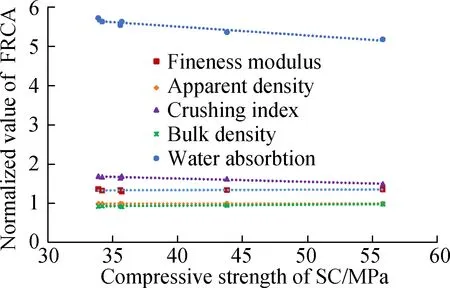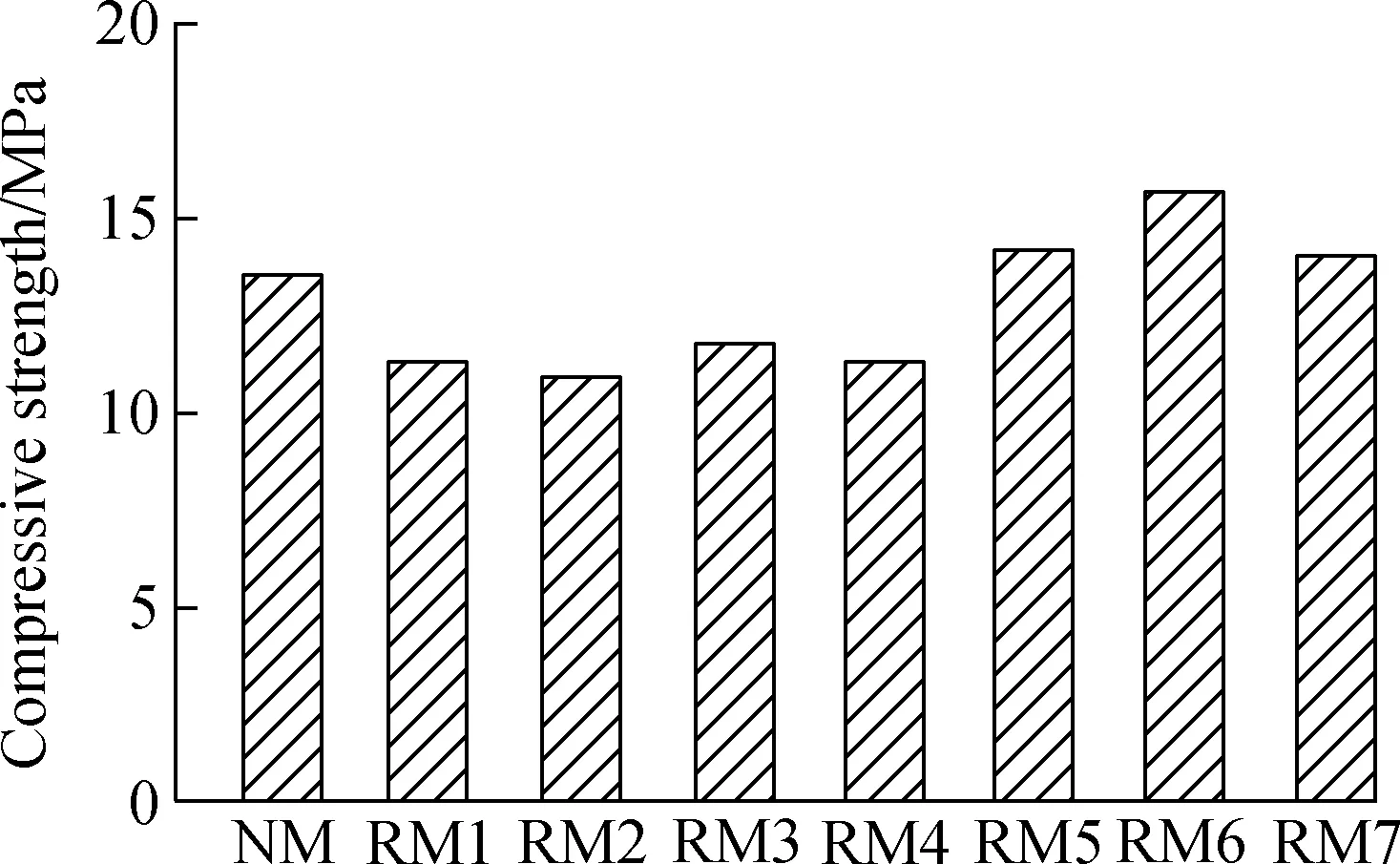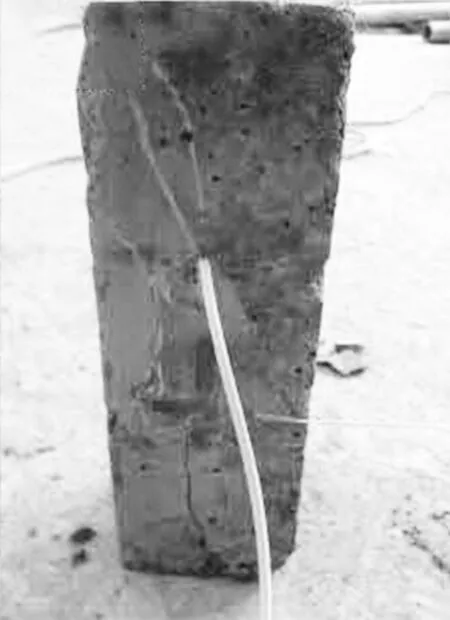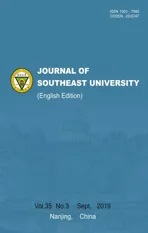Effect of waste concrete with different strengthon mechanical properties of recycled fine aggregate mortar
2019-10-15DingXiaomengChenZhongfanLiuQiongChenYang
Ding Xiaomeng Chen Zhongfan Liu Qiong Chen Yang
(1Key Laboratory of Concrete and Pre-Stressed Concrete Structures of the Ministry of Education,Southeast University, Nanjing 210096, China)(2College of Civil Engineering, Tongji University, Shanghai 200092, China)
Abstract:The influence of source concrete (SC) with different compression strengths on the workability and mechanical properties of recycled mortar made with river sand substituted by 100% fine recycled concrete aggregates (FRCA) is experimentally investigated. The basic physical performance test shows that with the increase in SC strength, FRCA exhibit lower water absorption and crushing index, meanwhile keeping higher densities. Mechanical property tests, including compressive strength, flexural strength and uniaxial compressive stress-strain tests, show that compressive strength,flexural strength and elasticity modulus of recycled sand mortars increase roughly with the increase in SC strength. The proposed mixture design method demonstrates that all of the components can be kept as the same as those in natural mortar mixture design and FRCA must be pre-wetted before making mortar mixture. Meanwhile, the reuse of higher strength SC can ensure that recycled mortar mixtures are able to achieve similar mechanical performance when compared to natural mortar designs.
Key words:fine recycled concrete aggregates (FRCA); recycled mortar with FRCA; source concrete (SC) strength; compressive strength; flexural strength; uniaxial compressive stress-strain test
The development of new construction leads to serious risk to the sustainability of our environment. In the construction process, natural resources such as crushed stone and river sands have been over-exploited; meanwhile, large amounts of construction and demolition waste (CDW) are generated every year over the world[1-4]. The use of recycled aggregates made from CDW that partially or fully replace natural aggregates has been widely developed over the world due to its potential to protect the environment and improve the sustainability of concrete manufacturing[5-8].
The existing CDW standards and recycling technologies applied in the construction concrete waste recycling systems have mainly focused on the production and usage of coarse recycled concrete aggregates (CRCA).However, few investigations involved the reutilization of fine recycled concrete aggregates (FRCA), although the fraction finer than 4.8 mm accounts for about 50% of the CRCA production, which is a considerable quantity[9-11]. General processing methods of reusing FRCA as road sub-base or for disposal in landfills are inefficient and also not environmental-friendly. As the research moves along, FRCA are now utilized as an alternative raw material for cement products[12-13], recycled mortar sands (in the current study)[14-19], and fine fraction in concrete production[20-22].
Regarding the research on recycled mortar with FRCA (sands), some conclusions have been drawn in recent years. Corinaldesi et al.[14-16]obtained that recycled aggregate mortars possessed poorer mechanical properties, such as compressive strength, tensile strength, flexural strength and elastic properties, in comparison to natural sand mortars. Regarding the influence of materials with a size finer than 0.63 mm, especially smaller than 75 μm, Miranda et al.[15-16]pointed out that the strength of recycled mortars decreases as the content of tiny fractions increases. Due to the negative impact on the achievement of good performance of recycled mortar, the content of the aforementioned tiny materials and the mixing ratio between recycled and natural aggregates should be controlled within certain limits.
Although the addition of the FRCA possesses adverse effects on mechanical performance, the recycled mortar still has some advantages compared to natural sand mortar. Corinaldesi et al.[14]conducted tests on the bond strength of recycled aggregate mortars on bricks as well as on compressive and the shear strengths of masonry units, and pointed out that the recycled aggregate mortars appeared to be superior to ordinary mortars in terms of mortar-brick bond strength and shear strength of masonry assemblages. Stefanidou et al.[17]explored the possibility of incorporating fine recycled sand originating from construction and demolition waste into lime-based traditional mortars. The results show that it is possible to incorporate recycled sand in lime mortars used as repair materials in historic buildings, attributing the reaction of lime to the Al and Si constituents of FRCA.
In addition, the influence of the saturation state of FRCA (dried or saturated) on the recycled mortar properties was also studied. Zhao et al.[16]illustrated that the recycled mortars with dried FRCA have a higher compressive strength than mortars with saturated FRCA, due to a thinner interfacial transition zone improving their mechanical performance.
It can be seen that the factors considered in the existing research include the incorporating ratio of FRCA, the content of materials finer than 75 μm and the saturation state of FRCA. However, it should be noticed that the waste concrete was collected from different sites and it always comprised of diverse strengths, which can make a difference to the property of the FRCA and affect the recycled mortar mixtures performance. To the best of the authors’ knowledge, no public report to date has specifically emphasized studying the influence of source concrete with varying strengths on the mechanical behavior of recycled mortar made with FRCA. Therefore, this paper attempts to support some experimental research results for the better reutilization of FRCA.
This paper investigates the influence of source concrete strength on the basic physical performance of fine recycled concrete aggregates and the mechanical behavior of recycled mortars with 100% recycled sands. Mechanical property tests on recycled mortar, including compressive strength, flexural strength and uniaxial compressive stress-strain tests are carried out.
1 Definition of Source Concrete
Due to the lack of research concerning the influence of source concrete on the recycled mortar mechanical properties, the definition of source concrete is conducted via the research results of recycled concrete. The entity of a given source concrete is defined by two factors: 1) The collecting site with controlled origins, e.g., a precast concrete company and laboratory, or without detailed information, such as a dump site and recycling plants; and 2) The strength of the waste concrete. Pedro et al.[22-23]carried out experimental studies and found that the recycled concrete made with similar strength waste concrete which was collected from the recycling plant, dump site and laboratory can have similar mechanical behavior. Hence, the collection site cannot be regarded as a relevant factor for defining the source concrete. According to the research by Pedro et al.[22,24-26], it can be observed that the mechanical properties of recycled concrete improve with the increase in waste concrete strength. Therefore, the source concrete will be defined by the waste concrete strength only.
2 Experimental Investigation
2.1 Source concrete
Seven types of waste concrete are numbered from SC1 to SC7. The concrete beam SC1 and SC2 are the research and teaching material waste at Southeast University, respectively. SC3 is the base support beam from a project in Jianye district, Nanjing. SC4, SC5 and SC6 are the laboratory specimens with different strengths, which were cast in different batches, respectively for the beam slab, ring beam and column. SC7 is the head of the filling pile concrete used in the Dadingfang project.
The age of the above waste concrete is within two years, so that the impact of service life on recycled concrete was not taken into account. The holes in SC1 and SC2 are the drilling sample holes. The measured compressive strength, shown in Tab.1, is adopted to evaluate the source concrete strength.

Tab.1 Results of the compression test of source concrete from SC1 to SC7
2.2 Fine recycled concrete aggregates
Before producing the fine aggregates, impurities such as wood, glass and other construction debris were removed. Subsequently, the source concrete has been washed and left dry at air contact. Source concrete were firstly crushed into small pieces manually and then mashed via a jaw crusher. After sieving, the fine aggregates numbered from FA1 to FA7 of sizes less than 4.75 mm were extracted (see Fig.1).

Fig.1 Fine recycled concrete aggregates (FRCA)
The basic performance tests, including grading analysis, fineness modulus, water absorption (30 min), apparent density, bulk density and crushing index, were conducted to characterize the fine aggregates according to the Chinese Code GB/T 25176—2010 and GB/T 14684—2011. The results are shown in Fig.2 and Tab.2.
2.3 Mortar mixture and specimen casting
In this study, the target strength grade of mortar is M10, and the fine recycled aggregates are reused to fully substitute river sand. In per cubic meter, the dosage of all ingredients are determined as follows: 424 kg of cement (composite Portland cement (CPC) P·C 32.5), 1 158 kg of the weight of FRCA (river sand in natural mortar), 195 kg of water with a constant water-cement ratio of 0.46.

Fig.2 Grading curves of fine aggregates

Tab.2 Properties of fine aggregates
Recycled sand mortar numbered from RM1 to RM7 was cast using recycled aggregates from FA1 to FA7, respectively. Mortar mixtures with the sizes of 70.7 mm×70.7 mm×70.7 mm, 40 mm×40 mm×160 mm and 70.7 mm×70.7 mm×216 mm were filled to determine compressive strength, flexural strength and uniaxial compression stress-strain tests, respectively.
Due to a high absorption capacity, FRCA must be pre-wetted before its utilization in making mortar mixture. In the current study, mortar mixtures were mixed by the JJ-5 cement sand mixer. The mixer should be in conform to industry standards of the JG/T 3033. Premixing is needed to ensure an accurate mix proportion before the formal mixing process. In the mixing process, firstly start with the mixer and simultaneously add cement and sand to the mixer in turn. When dry mixtures are mixed evenly, add water slowly. The feeding time of components should be limited to less than 2 min. After all water is added, continue to mix for more than 2 min. A plastic consistency in accordance to industry standards of JGJ/T 70—2009 was achieved. The mortar specimens were demoulded after 24 h and kept in a curing room until the test age of 28 d.
The mechanical tests were carried out in accordance with the Chinese code JGJ/T 70—2009 and GBT 17671—1999. In the testing procedure, the compressive strength, flexural strength and uniaxial compression stress-strain tests were conducted using compression testers with the loading capacity of 2 MN, 300 kN, and MTS370.50 electrohydraulic servo tester, respectively.
3 Results and Discussion
3.1 Property of FRCA
From Fig.2, it can be noticed that the FRCA presents continuous size grading which is similar to that of river sand. The fineness modulus of FRCA locating from 3.4 to 3.54 belongs to rough sand; while, the river sand belongs to medium sand. Due to the presence of old cement mortar adhered to the source concrete, the FRCA have a much higher water absorption and porosity property compared to that of natural sand. As observed for the crushing index, the values of FRCA are about 49% to 69% higher than that of natural ones, which can be explained by the lower intrinsic strength of FRCA due to the massive micro-cracks produced during the crushing process. Exactly for the same reasons that determined higher porosity, the apparent and bulk densities of FRCA are evidently lower than those of river sand.
The relationship between the FRCA properties and the source concrete strength is presented in Fig.3. The ordinate represents the normalized value of FRCA properties compared to that of river sand. The most evident influence of source concrete strength on the FRCA property is on their water absorption capacity. It can be seen that as the source concrete strength increases, the values of water absorption decrease drastically while the other four indices decrease gradually. It can be observed that the FRCA from source concrete with a higher strength can have a better quality, i.e., lower water absorption and crushing index, but also higher bulk and apparent densities.

Fig.3 Relationship between FRCA properties and SC strength
3.2 Compressive and flexural strengths tests
The results obtained from compression and flexural strength tests are shown in Fig.4. It can be seen that the source concrete numbered from SC1 to SC4 have similar compressive strengths of about 35 MPa with the strength difference less than 3 MPa, and the mixtures from RM1 to RM4 made of SC1 to SC4 also have similar compression and flexural strengths. The test result confirms that it is appropriate to define source concrete from the waste concrete strength only, without taking into account the collection site. Moreover, the result is consistent with the law on the impact of similar source concrete strength on recycled concrete with course recycled concrete aggregates by Pedro et al.[22-23]. While compared to those of natural sand mortar, the compressive and flexural strengths decrease approximately 19% and 23%, respectively. The strength loss is certainly attributed to the poor quality of recycled sand caused by abundant micro-cracks generated during the crushing process. As observed in the testing procedure, some recycled aggregates in recycled mortar are damaged (see Fig.5); while, in river sand mortar, the failure occurred between the interface of the river sand and cement paste.

(a)

(b)
When the strengths of SC5, SC6 and SC7 are larger than 40 MPa, the mortars of RM5, RM6 and RM7 can have higher compressive and flexural strengths in comparison to those of RM1 to RM4. This might be ascribed to the good quality of FRCA made from higher strength source concrete which can have fewer micro-cracks. It can also be observed that during the testing process, the quantity of broken recycled aggregates became smaller with the increase in source concrete strength.

Fig.5 Recycled aggregate damage in recycled mortar mixture
Fig.6 shows the relationship between normalized compressive and flexural strengths of recycled mortar and source concrete strengths. It can be seen that with the increase in source concrete strength, the compressive and flexural strengths of recycled sand mortars roughly increase. This result is in conformity with the experimental studies[22, 24-26]on recycled concrete with coarse recycled concrete aggregates. The ordinate represents the normalized value of RM compression and flexural strengths compared to natural mortar. From Fig.6, it can be deduced that when the source concrete strength reaches 42.2 MPa, the flexural strength of recycled mortar can satisfy the strength requirement in contrast to natural mortar. Furthermore, as the source concrete strength is greater than 44.5 MPa, the compressive strength can also achieve the design strength. It should be noted that the flexural strength can meet the strength requirement relatively easily in comparison to compressive strength, which might be ascribed to the presence of the old mortar attached to FRCA. Sri Ravindrarajah and Tam[27]pointed out that the adhered mortar can decrease the toughness of recycled aggregates leading to the compression strength loss of recycled mixture. Nonetheless, it also roughened the particle surface and resulted in enhanced bond strength between the particles and the cement paste.

Fig.6 Relationship between normalized strengths of recycled mortar and SC strength
3.3 Uniaxial compressive stress-strain test
Figs.7 and 8 show the failure pattern and uniaxial compressive stress-strain curves of the whole set of mortar mixtures. Tab.3 presents the characteristic parameters of the uniaxial compressive stress-strain curves.

(a)

(c)

(e)

(g)
Fig.7Failure patterns of mortar mixtures under uniaxial compression test. (a) NM; (b) RM1; (c) RM2; (d) RM3; (e) RM4; (f) RM5; (g) RM6; (h) RM7

Fig.8 Uniaxial compressive stress-strain curves of mortar mixtures

SpecimenPeakstressfc/MPaPeakstrainεc /10-3Ultimatestrainεcu /10-3ElasticitymodulusE/GPaPoissonratiovNM14.201.5401.75018.990.163RM19.906.3727.92818.400.160RM29.666.5448.07418.060.182RM310.206.7438.42318.210.158RM410.666.5868.03918.960.168RM511.786.2668.15720.280.148RM613.365.5986.27623.000.147RM712.035.8727.85421.690.150
In the loading process, it can be observed that the recycled mortars have similar characteristics to that of natural mortar, i.e., all the mortar specimens undergo processes of generating cracks, peeling and missing angles. At the beginning of the loading, there are no macroscopic cracks; meanwhile, the strain increases approximately linearly. As the control displacement continues to increase, the stress-strain curve slope becomes smaller and the curve shape deviates from the straight line. When the stress is approaching its peak value, the first visible crack arises and then gradually extends obliquely to the ends; simultaneously, the stress drops quickly resulting from the internal defects of specimens, e.g., micro-cracks, the distribution of fine aggregates and construction quality. The failure pattern is splitting failure with a relatively neatly cleavage fracture without longitudinal cracks.
Although the recycled mortars exhibit similar oblique splitting failure compared with natural mortar, there are evident differences among the recycled mortars with different source concrete strengths. It can be noticed that the recycled mortar from RM1 to RM4 has more cracks (see Fig.7) as well as lower peak stress and elasticity modulus (see Tab.3) than mortars of RM5, RM6, and RM7. This should also be attributed to the same reason that determined compressive and flexural strengths behaviors. Hou et al.[28]pointed out that the higher the strength grade of the original concrete is, the more cement mortar will adhere to the surface of recycled aggregates. It can be inferred that when the old mortar content is high, the content of un-hydrated cement will be high. Consequently, the actual water-cement ratio will be low. That is to say, under the same nominal mixture proportion of concrete, the recycled concrete configured with high-strength source concrete will have a lower actual water-cement ratio, and thus the corresponding mechanical properties might be slightly better than that of the normal one.
4 Conclusions
1) The FRCA crushed from source concrete with higher compression strength can have a better quality, i.e., lower water absorption and crushing index, but also higher bulk and apparent density in comparison to river sand.
2) For the recycled mortar with river sand substituted by 100% FRCA, compression strength, flexural strength and elasticity modulus of recycled sand mortars increase roughly with the increase in source concrete strength.
3) In the proposed mixture design, all the components can be determined to be the same as those in natural mortar; and the recycled mortar can obtain comparable compressive strength and flexural strength if the SC strengths are higher than 44.5 and 42.2 MPa, respectively.
4) This study has valuable engineering significance due to the diversity of source concrete strengths. Current studies are focused on the investigation of recycled mortar with FRCA from single SC. For wide reutilization of waste concrete, further study on recycled mortar made with the mixed SC should be carried out.
杂志排行
Journal of Southeast University(English Edition)的其它文章
- Travel time prediction model of freewaybased on gradient boosting decision tree
- Rolling contact fatigue nondestructive testing system for a bearing inner ring based on initial permeability
- Delay-performance optimization resource scheduling in many-to-one multi-server cellular edge computing systems
- Image denoising method with tree-structured group sparse modeling of wavelet coefficients
- Projection pursuit model of vehicle emission on air pollution at intersections based on the improved bat algorithm
- Experimental investigation of oil particles filtration on carbon nanotubes composite filter
